One of the things on our construction schedule this year, is to complete the floor of our wooden church. Currently there is a floor composed of compacted clay, which is already quite hard and durable. This is but only the first layer, which serves as a substructure for the final floor.
To achieve a smooth and worthy-looking floor we apply two layers of plaster made up of clay, sand and burnt lime. The first layer will also have some straw mixed in, so that it dries relatively crack-free and binds together well. The final, uppermost layer will then have a higher burnt lime-content and no straw at all, so that it is possible to have a flat and smooth surface which is aesthetically well in line with the rest of the interior of the church.
Here is how we do it:
1. 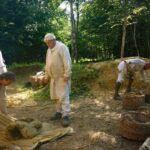 As a first step, the clay has to be cleaned from stones and debris. The clay comes from the trenches we dug for the foundations of the church. This material was shouveled out 2014 and has been deposited as a heap close to the church. Our potter uses this material as well, as its clay content is high enough to shape pots from it on the wheel.
As a first step, the clay has to be cleaned from stones and debris. The clay comes from the trenches we dug for the foundations of the church. This material was shouveled out 2014 and has been deposited as a heap close to the church. Our potter uses this material as well, as its clay content is high enough to shape pots from it on the wheel.
2. 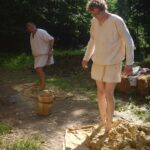 The clay then has to be softened and homogenized by trampling. For the first layer, straw is now mixed in as well. (The straw comes from our own fields, but has been pressed into bales for easier storage outside of our site in Winter.)
The clay then has to be softened and homogenized by trampling. For the first layer, straw is now mixed in as well. (The straw comes from our own fields, but has been pressed into bales for easier storage outside of our site in Winter.)
3. 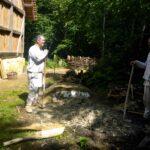 Heaps of mortar from burnt lime and sand had been prepared already a few days earlier. The mortar can now be stirred and mixed with the clay or clay-straw-mixture.
Heaps of mortar from burnt lime and sand had been prepared already a few days earlier. The mortar can now be stirred and mixed with the clay or clay-straw-mixture.
4. 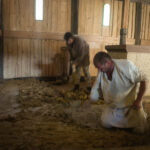
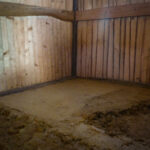
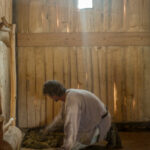 The prelimiary floor (the mentioned substructure) has been soaked with water for few days, and now the new material is applied. In between the worksteps and the application of further material, the floor is stamped and pulled flat, and its surface finally rolled. This latter step will have to be repeated several times during the drying process until a compact and smooth surface is achieved.
The prelimiary floor (the mentioned substructure) has been soaked with water for few days, and now the new material is applied. In between the worksteps and the application of further material, the floor is stamped and pulled flat, and its surface finally rolled. This latter step will have to be repeated several times during the drying process until a compact and smooth surface is achieved.
In all, the whole process takes longer than expected. Although many craftsmen and helpers are working hand in hand, the many working steps take their time. But as always, there is no shortcut in traditional crafts, it takes as long as it takes… or as we like to say:
„It is not good when it is done, but it is done, when it is good!“